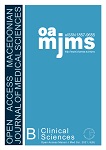Controlled Clinical Trial Effect of Noni Fruit Extract (Morinda citrifolia) Toward Overactive Bladder Women through Observation of High-Sensitivity C-reactive Protein in Urine Levels
DOI:
https://doi.org/10.3889/oamjms.2020.4693Keywords:
Overactive women bladder, Morinda citrifolia, High-sensitivity C-reactive proteinAbstract
BACKGROUND: The prevalence of overactive bladder (OAB) appears to increase with age (aging), and free radicals most contribute to an increase in the aging process. But now, some researchers have found the efficacy of Morinda citrifolia in inhibiting the oxidative stress process so that it is expected to be beneficial for the treatment of OAB.
AIM: The aim of this study was to find out the effect of M. citrifolia extract on overactive women bladder (OAB) through observation of high-sensitivity C-reactive protein (hs-CRP) urine level.
METHODS: This research is an experimental study using double-blind randomized controlled trial design conducted at General Hospital H. Adam Malik Medan, USU Pharmacy Laboratory for extraction of noni fruit (M. citrifolia) and the Integrated Laboratory of Biochemical-Biomolecular USU Faculty of Medicine for the examination of hs-CRP urine levels. A t-dependent test is performed if data distribution is normally distributed or if not normally distributed, the median values are compared with the Mann–Whitney U-test. The effect of noni in hs-CRP levels performed by wilcoxon signed-Ranks Test. The statistical significance test with CI 95% and significant difference value p<0,05.
RESULTS: These results indicate that the noni fruit extract has weak antioxidant activity (IC50 >150 ppm). From the statistical analysis, a significant difference (p < 0.05) was obtained in hs-CRP urine level after compared to before treatment. These results indicate that after treatment, there was an improvement in the degree of OAB symptom scores in Group A and Group B.
CONCLUSIONS: Noni fruit extract (M. citrifolia) is proven to be able to inhibit oxidative stress in urothelium through observation of hs-CRP urine levels in overactive women bladder (OAB).
Downloads
Metrics
Plum Analytics Artifact Widget Block
References
Buckley BS, Carmela M, Lapitan MC. Prevalence of urinary incontinence in men, women, and children-current evidence: Findings of the fourth international consultation on incontinence. Urology. 2010;76(2):265-71. https://doi.org/10.1016/j. urology.2009.11.078 PMid:20541241
Milsom I, Coyne KS, Nicholson S, Kvasz M, Chen CI, Wein AJ. Global prevalence and economic burden of urgency urinary incontinence: A systematic review. Eur Urol 2014;65(1):79-95. https://doi.org/10.1016/j.eururo.2013.08.031 PMid:24007713
Vignoli G. UDS in overactive bladder syndrome (OAB-S). In: Vignoli G, editor. Urodynamic for Urogynecologists. Bologna, Italia: Springer; 2018. p. 131-47. https://doi. org/10.1007/978-3-319-74005-8_9
Stewart WF, Van Rooyen JB, Cundiff GW, Abrams P, Herzog AR, Corey R, et al. Prevalence and burden of overactive bladder in the United States. World J Urol. 2003;20(6):327-36. https://doi. org/10.1007/s00345-002-0301-4 PMid:12811491
Chapple CR, Rechberger T, Al Shukri S, Meffan P, Everaer K, Huangs M et al. 2004. Randomized, double-blind placebo and tolterodine controlled trial of the oncedaily antimuscarinic agent solifenacin in patients with symptomatic overactive bladder. BJU Int, 93:303-310.
Link CL, Steers WD, Kusek JW, McKinlay J. The association of adiposity and overactive bladder appears to differ by gender: Results from the Boston area community health survey. J Urol. 2011;185(3):955-63. https://doi.org/10.1016/j.juro.2010.10.048 PMid:21247604
Herrera MD, Mingorance C, Rodriguez-Rodriguez R, de Sotomayor MA. Endothelial dysfunction and aging: An update. Ageing Res Rev. 2010;9(2):142-52. https://doi.org/10.1016/j. arr.2009.07.002 PMid:19619671
Dupont MC, Spitsbergen JM, Kim KB, Tuttle JB, Steers WD. Histological and neurotrophic changes triggered by varying models of bladder inflammation. J Urol. 2001;166(3):1111-8. https://doi.org/10.1097/00005392-200109000-00093
Chung SD, Liu HT, Lin H, Kuo HC. Elevation of serum c-reactive protein in patients with OAB and IC/BP implies chronic inflammation in the urinary bladder. Neurourol Urodyn. 2011;30(3):417-20. https://doi.org/10.1002/nau.20938 PMid:21284020
Steers WD. Pathophysiology of overactive bladder and urge urinary incontinence. Rev Urol. 2002;4(4):S7-18. PMid:16986023
Lawrence JM, Lukacz ES, Liu IL, Nager CW, Luber KM. Pelvic floor disorders, diabetes, and obesity in women: Findings from the Kaiser Permanente continence associated risk epidemiology study. Diabetes Care. 2007;30(10):2536-41. https://doi. org/10.2337/dc07-0262 PMid:17620443
Rovner ES, Rolef J. Diagnosis of overactive bladder. In: Cox L, Rovner ES, editors. Contemporary Pharmacotherapy of Overactive Bladder. Switzerland, AG: Springer Nature; 2018. p. 13-5. https://doi.org/10.1007/978-3-319-97265-7_2
Guirguis N, Heit M. Urinary biomarkers under investigation for overactive bladder syndrome. Curr Bladder Dysfunct Rep. 2015;10(4):355-61. https://doi.org/10.1007/ s11884-015-0324-5
Volanakis JE. Human C-reactive protein: Expression, structure, and function. Mol Immunol. 2001;38:189-97. https://doi. org/10.1016/s0161-5890(01)00042-6 PMid:11532280
Srinivasahan V, Durairaj B. Antioxidant dan free radical scavenging effect of extract Morinda citrifolia. fruit. Int J Pharm Pharm Sci. 2014;6(4):55-9.
Suskind AM. The aging overactive bladder: A review of aging-related changes from the brain to the bladder. Curr Bladder Dysfunct Rep. 2017;12(1):42-7. https://doi.org/10.1007/ s11884-017-0406-7 PMid:28947924
Kupellian V, McVary KT, Barry MJ, Link CL, Rosen RC, Lalith PA, et al. Association of C-reactive protein and lower urinary tract symptoms in men and women: Results from Boston area community health survey. Urology. 2009;73(5):950-7. https:// doi.org/10.1016/j.urology.2008.12.012 PMid:19394490
Andersson KE, Arner A. Urinary bladder contraction and relaxation: Physiology and pathophysiology. Physiol Rev. 2004;84(3):935-86. https://doi.org/10.1152/physrev.00038.2003 PMid:15269341
Chuang FC, Hsiao SM, Kuo HC. The overactive bladder symptom score, international prostate symptom score-storage subscore, and urgency severity score in patients with overactive bladder and hypersensitive bladder: Which scoring system is best? Int Neurourol J. 2018;22(2):99-106. https://doi. org/10.5213/inj.1832554.277 PMid:29991231
de Sousa BC, Miguel CB, Rodrigues WF, Machado JR, da Silva MV, da Costa TA, et al. Effects of short-term consumption of Morinda citrifolia (Noni) fruit juice on mice intestine, liver and kidney immune modulation. Food Agric Immunol. 2017;28(3):528-42. https://doi.org/10.1080/09540105.2017.130 6492
Wang MY, Peng L, Jensen CJ, Deng S, West BJ. Noni juice reduces lipid peroxidation-derived DNA adducts in heavy smokers. Food Sci Nutr. 2013;1(2):141-9. https://doi. org/10.1002/fsn3.21 PMid:24804023
Downloads
Published
How to Cite
License
Copyright (c) 2020 Edy Ardiansyah, M. F. G. Siregar, R. A. Ganie, I. B. utra (Author)

This work is licensed under a Creative Commons Attribution-NonCommercial 4.0 International License.
http://creativecommons.org/licenses/by-nc/4.0








